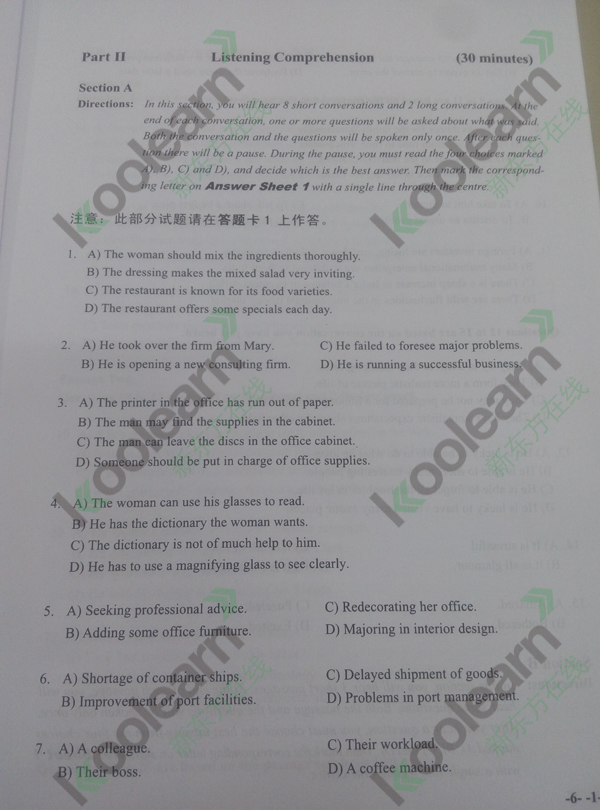2009年6月英语六级真题
2016年6月的英语六级考试即将举行,在有限的备考时间里,考生应多多研究往年真题。
2009年6月英语六级真题
Part I Writing (30 minutes)
Directions: For this part, you are allowed 30 minutes to write a short essay entitled On the Importance of a Name. you shuold write at least 150 words following the outline given below.
1. 有人说名字或名称很重要
2. 也有人觉得名字或名称无关紧要
3. 我认为
On the Importance of a Name
Part II Reading Comprehension (Skimming and Scanning) (15 minutes)
Directions: In this part, you will have 15 minutes to go over the passage quickly and answer the questions on Answer Sheet 1. For questions 1-7, choose the best answer from the four choices marked A., B., C.and D.. For questions 8-10, complete the sentences with the information given in the passage.
Helicopter Moms vs. Free-Range KidsWould you let your fourth-grader ride public transportation without an adult? Probably not. Still, when Lenore Skenazy, a columnist for the New York Sun, wrote about letting her son take the subway alone to get back to "Long story short:my son got home from a department store on the Upper East Side, she didn’t expect to get hit with a wave of criticism from readers.
“Long story short: My son got home, overjoyed with independence,” Skenazy wrote on April 4 in the New York Sun. “Long story longer: Half the people I’ve told this episode to now want to turn on in for child abuse. As if keeping kids under lock and key and cell phone and careful watch is the right way to rear kids. It’s not. It’s debilitating (使虚弱)—for us and for them.”
Online message boards were soon full of people both applauding and condemning Skenazy’s decision to let her son go it alone. She wound up defending herself on CNN (accompanied by her son) and on popular blogs like the buffington post, where her follow-up piece was ironically headlined “More From America’s Worst Mom.”
The episode has ignited another one of those debates that divides parents into vocal opposing camps. Are Modern parents needlessly overprotective, or is the world a more complicated and dangerous place than it was when previous generations were allowed to wander about unsupervised?
From the “she’s an irresponsible mother” camp came: “Shame on you for being so careless about his safety,” in Comments on the buffongton post. And there was this from a mother of four: “How would you have felt if he didn’t come home?” But Skenazy got a lot of support, too, with women and men writing in with stories about how they were allowed to take trips all by them selves at seven or eight. She also got heaps of praise for bucking the “helicopter parent” trend: “Good for this Mom,” one commenter wrote on the buffongton post. “This is a much-needed reality check.”
Last week, encouraged by all the attention, Skenazy started her own blog—Free Range, kids—promoting the idea that modern children need some of the same independence that her generation had. In the good old days nine-year-old baby boomers rode their bikes to school, walked to the store, took buses—and even subways—all by themselves. Her blog, she says, is dedicated to sensible parenting. “At Free Range Kids, we believe in safe kids. We believe in car seats and safety belts. We do NOT believe that every time school-age children go outside, they need a security guard.”
So why are some parents so nervous about letting their children out of their sight? Are cities and towns less safe and kids more vulnerable to crimes like child kidnap and sexual abuse than they were in previous generations?
Not exactly. New York City, for instance, is safer than it’s ever been; it’s ranked 36th in crime among all American cities. Nationwide, stringer kidnaps are extremely rare; there’s a one-in-a-million chance a child will be taken by a stranger, according to the Justice Department. And 90 percent of sexual abuse cases are committed by someone the child knows. Mortality rates from all causes, including disease and accidents, for American children are lower now than they were 25 years’ ago. According to Child Trends, a nonprofit research group, between 1980 and 2003 death rates dropped by 44 percent for children aged 5 to 14 and 32 percent for teens aged 15 to 19.
Then there’s the whole question of whether modern parents are more watchful and nervous about safety than previous generations. Yes, some are. Part of the problem is that with wall to wall Internet and cable news, every missing child case gets so much airtime that it’s not surprising even normal parental anxiety can be amplified. And many middle-class parents have gotten used to managing their children’s time and shuttling them to various enriching activities, so the idea of letting them out on their own can seem like a risk. Back in 1972, when many of today’s parents were kids, 87 percent of children who lived within a mile of school walked or biked every day. But today, the Centers for Disease Control report that only 13 percent of children bike, walk or otherwise t themselves to school.
The extra supervision is both a city and a suburb phenomenon. Parents are worried about crime, and they are worried about kids getting caught in traffic in a city that’s not used to pedestrians. On the other hand, there are still plenty of kids whose parents give them a lot of independence, by choice or by necessity. The After School Alliance finds that more than 14 million kids aged 5 to 17 are responsible for taking care of themselves after school. Only 6.5 million kids participate in organized programs. “Many children who have working parents have to take the subway or bus to get to school. Many do this by themselves because they have no other way to get to the schools,” says Dr. Richard Gallagher, director of the Parenting Institute at the New York University Child Study Center.
For those parents who wonder how and when they should start allowing their kids more freedom, there’s no clear-cut answer. Child experts discourage a one-size-fits-all approach to parenting. What’s right for Skenazy’s nine-year-old could be inappropriate for another one. It all depends on developmental issue, maturity, and the psychological and emotional makeup of that child. Several factors must be taken into account, says Gallagher. “The ability to follow parent guidelines, the child’s level of comfort in handling such situations, and a child’s general judgment should be weighed.”
Gallagher agrees with Skenazy that many nine-year-olds are ready for independence like taking public transportation alone. “At certain times of the day, on certain routes, the subways are generally safe for these children, especially if they have grown up in the city and have been taught how to be safe, how to obtain help if they are concerned for their safety, and how to avoid unsafe situations by being watchful and on their toes.”
But even with more traffic and fewer sidewalks, modern parents do have one advantage their parents didn’t: the cell phone. Being able to check in with a child anytime goes a long way toward relieving parental anxiety and may help parents loosen their control a little sooner. Skenazy got a lot of criticism because she didn’t give her kid her cell phone because she thought he’d lose it and wanted him to learn to go it alone without depending on mom—a major principle of free-range parenting. But most parents are more than happy to use cell phones to keep track of their kids.
And for those who like the idea of free-range kids but still struggle with their inner helicopter parent, there may be a middle way. A new generation of GPS cell phones with tracking software make it easier than ever to follow a child’s every movement via the Internet—without seeming to interfere or hover. Of course, when they go to college, they might start objecting to being monitored as they’re on parole (假释).
- 相关阅读
-
2019年12月英语六级真题及答案-卷三汇总版(网络版)
新东方在线英语六级频道考后发布2019年12月英语六级真题及答案-卷三汇总版(网络版),同时新东方实力师资团队将对英语六级真题答案做
2021-10-12 -
2019年12月英语六级真题试卷三(新东方在线)
2019年12月英语六级真题试卷三(新东方在线)
2021-10-12 -
2019年12月英语六级真题及答案-卷三汇总版(新东方在线)
2019年12月英语六级真题及答案-卷三汇总版(新东方在线)
2021-10-12 -
2019年12月英语六级真题及答案[卷二完整版]
新东方在线英语六级频道考后发布2019年12月英语六级真题及答案[卷二完整版],同时新东方实力师资团队将对英语六级真题答案做权威解
2021-10-12 -
2018年12月英语六级真题第三套写作范文-平衡工作和休闲娱乐
新东方在线英语六级频道考后发布2018年12月英语六级真题第三套写作范文-平衡工作和休闲娱乐,同时新东方实力师资团队将对英语六级
2021-10-12 -
2015年12月英语六级真题卷二
新东方在线英语六级频道考后首发2015年12月英语六级真题卷二,同时新东方名师将对真题答案进行权威解析,请考生关注。更多2015年12月
2021-10-12 -
2015年12月英语六级真题试卷卷二
新东方在线英语六级频道考后首发2015年12月英语六级真题试卷卷二,同时新东方名师将对真题答案进行权威解析,请考生关注。更多2015年
2021-10-12













